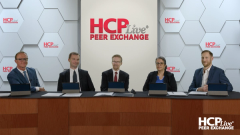
Long-Term Monitoring of Teplizumab in T1D
Expert endocrinologists discuss implementing long-term monitoring of patients being treated with teplizumab for type 1 diabetes and review the PROTECT study for patients who are newly diagnosed with T1D.
Episodes in this series

Steve Edelman, MD: Teplizumab has been around since 2002. It’s been owned by a couple of different companies. TrialNet owned it for a while, and then it was purchased by a different company. They finished the clinical trials. Are there any long-term things to follow up on your patients? They made it past the infusion, and most patients do extremely well. How are you following them over the long term?
Justin M. Gregory, MD, MSCI: That’s an open question. As teplizumab moves into the clinical realm, there’s no consensus about how soon you should see these children. There are some things we’re interested in. Early on, do you repeat oral glucose tolerance tests? How often do you do them? What do you measure? Do you do a simple 120-minute oral glucose tolerance test? Or do you try to better characterize the glucose time profile? Do you just get glucose? Do you get insulin and C-peptide? These questions are still out. An important thing that we should keep in mind about the pivotal trial is that it’s 71 patients. There’s a lot more for us to learn about what this drug is going to do and for whom it will give the greatest benefit. Certain HLA haplotypes in that trial didn’t do as well as others. Certain autoantibodies didn’t do as well as others. As we’re moving into what I’ll call the immunotherapy era of taking care of type 1 diabetes, we must be thoughtful about how we set up these follow-up clinics. I’d rather do more follow-up than less. In that first year, we’re going to see patients at 3, 6, and 12 months and do oral glucose tolerance tests each time. My hope is that we’ll get a sense of how quickly these children progress and whether we need to spread those out.
Steve Edelman, MD: What about putting a CGM [continuous glucose monitor] on them for 24 hours or 1 week?
Justin M. Gregory, MD, MSCI: That’s great. You have a highly controlled setting, and you’re bringing patients in for the fasting oral glucose tolerance test, but there’s a lot more to be learned in the real-world setting. It’s not just glucose. It’s things like glycemic variability and coefficient of variation of glucose. You hope the retention of some endogenous insulin secretion helps those substantially. We’ll see, but it would be nice to have real data.
Steve Edelman, MD: Yes. We’re going to get more and more.
Linda A. DiMeglio, MD: On the flip side, I’ve been thinking more about whether we could use urine glucose in those settings sometimes for occasional monitoring because it doesn’t involve any finger sticks or technology. You could potentially do it because what you want to know is when enough patients are hyperglycemic in it. Once patients get teplizumab, often they get hyperglycemic for a little while. Sometimes they need to be on insulin for a little while, but then it settles down in the responders and they’ll be off. That would be a low-tech option. It won’t give you all the data we need to move things forward, but it’s an interesting idea.
Steve Edelman, MD: The [TrialNet] TN10 was for patients with stage II and positive antibodies. That’s prevention, but there’s another study in stage III that’s more in the preservation category. Egils, tell us about the PROTECT study.
Egils K. Bogdanovics, MD: The PROTECT trial is children and adolescents, 8 to 17 years old, who have been diagnosed with stage III within the last 6 weeks. It’s treatment, not prevention. It’s going to look at these 2 infusions 6 months apart. By the way, it’s 12 days as opposed to 14 days, and the main reason for that is convenience logistics. They won’t have 2 weekends of infusions, whether it’s at home or at an infusion center that’s closed on weekends.
Steve Edelman, MD: It’s all about the nurses.
Egils K. Bogdanovics, MD: Absolutely. But they’ll be followed for 18 months to see the effect on C-peptide. The secondary goal is to look at metrics of diabetes management. You mentioned earlier that if you’ve got a little endogenous insulin secretion, you not only get better control but have less hypoglycemia, and you can turn off that insulin. There’s less variability and less hypoglycemia, and the honeymoon period will perhaps go longer.
Transcript edited for clarity.
Newsletter
Access practical, evidence-based guidance to support better care for our youngest patients. Join our email list for the latest clinical updates.







